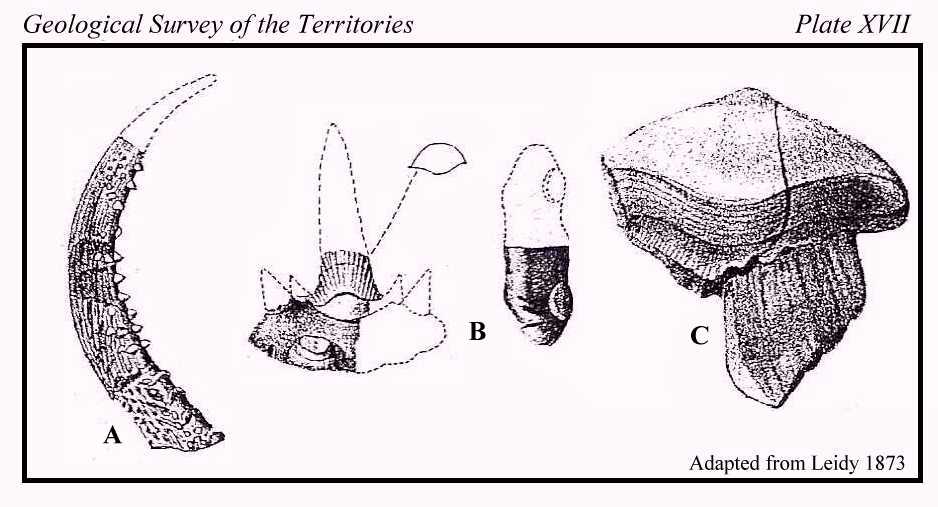
Xystracanthus, Cladodus and Petalodus from the Carboniferous of Kansas.
 |
Xystracanthus, Cladodus and Petalodus from the Carboniferous of Kansas.
Remarks by Joseph Leidy, as recorded in theProceedings of the Academy of Natural Sciences of Philadelphia, 11:3 (Meeting of January 18, 1859).Copyright © 2003-2012 by Mike EverhartePage last updated 11/16/2012 |
Wherein, Joseph Leidy describes a dorsal spine and two teeth of three different species of Paleozoic sharks found in near Leavenworth City, Manhattan, and Fort Riley, two years before Kansas became a state. (Above, left to right, A) Xystracanthus, B) Cladodus, C) Petalodus). The Xystracanthus dorsal spine may be actually be from another shark genus called Physonemus. This paper is important because it is the first description of Permian vertebrates from Kansas, and one of the first on Permian vertebrates of North America. Leidy was incorrect, however, when he stated that the two teeth were from the Carboniferous formations (they are Permian), although he had been informed of the correct age by Meek and Hayden.
|
NATURAL SCIENCES OF PHILADELPHIA
3 ... Dr. Leidy called the attention of the members to some remains of cartilaginous fishes, discovered by Dr. F. V. Hayden and F. B. Meek, during the last summer [1858], in the carboniferous formations of Kansas. One of these is a mutilated dorsal spine included in a fragment of rock, from the upper carboniferous formation of Leavenworth City. The spine may perhaps belong to one of the same fishes, to which the other specimens appertain, but there was no means at present to determine this fact. It was characterized as follows: XYSTRACANTHUS ARCUATUS Leidy. Spine much curved; its posterior border forming the segment of a circle whose diameter would be about 2 inches. Length along the convex border, when perfect, about 2½ inches. Lower extremity 3½ lines wide. Section ovoid with the broader part posterior. Sides of the spine finely ridged longitudinally, and furnished anteriorly with small, oblique, hemi-elliptical tubercles; posteriorly provided, on the two sides together, with six rows of odontoid tubercles, of which those of the first row on each side are minute, and of the last row are the largest. Osseous structure of the specimen brown; odontoid tubercles invested with smooth, shining gray, enameloid substance, demi-conoidal, those of the posterior pair of rows sometimes coalescing across the back border of the spine and assuming a crescentoid form. The second specimen was the fragment of a tooth, of a species of Cladodus, obtained from the Manhattan upper coal measures. It was characterized as follows: CLADODUS OCCIDENTALIS Leidy. Enameled crown, when perfect, about an inch in length, demi-conical; the outer convex side provided with narrow oblique folds. Lateral denticles two, the outer one the larger. Base of the tooth reniform, with a breadth of about an inch, and the short diameter about 5 lines; lateral extremities provided with a pair of large ovoid tubercles, one above the inner margin, the other below the outer margin. The third specimen is a tooth, apparently of PETALODUS ALLEGHANIENSIS,* from the upper carboniferous rocks, near Fort Riley. It differs from the tooth, upon which the species was originally founded, in no important point, except that it is larger. The breadth of the crown is about twenty lines; its height on the convex side 10 lines, on the concave side 1 inch. [Note: In measuring these specimens, Leidy uses 12 lines = 1 inch] _____________________________________________________________ * Journ. Acad. Nat. Sci. iii,161. 1859 |
All of the teeth shown below were collected by Keith Ewell, and come from the same shark-tooth-rich horizon in the Council Grove Group (Lower Permian) of Wabaunsee County, Kansas.
Credits: I thank Keith Ewell for the loan of these teeth, and the opportunity to learn more about these early sharks; and Earl Manning for copies of Leidy 1859 and Leidy 1873, suggestions on this webpage and our on-going discussion of Kansas sharks and other remains of marine vertebrates.
Suggested references:
Chorn, J. and D. Frailey. 1978. A large chondrichthyan spine, Physonemus mirabilis, from the Upper Pennsylvanian of Kansas, U.S.A. N. Jb. Geol. Paläont. Mh., (7):385-392, 1 fig.
Leidy, J. 1859. [Xystracanthus, Cladodus and Petalodus from the Carboniferous of Kansas]. Proc. Acad. Nat. Sci. Phila., 11:3.
Leidy, J. 1873. Contributions to the extinct vertebrate fauna of the western territories. Rept., U.S. Geol. Surv. Terrs. (Hayden), 1:358 p., 37 pls.
Williams, M. E. 2001. Tooth retention in Cladodont sharks: with a comparison between primitive grasping and swallowing, and modern cutting and gouging feeding mechanisms. Journ. Vert. Paleon. 21(2):214-226. (Click for the web version of this paper: "Jaw, The Early Years")